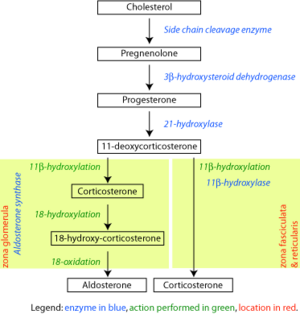Corticosteroid
Corticosteroid is any of a class of steroid hormones that either are produced in the adrenal cortex or are synthetic analogues. Corticosteroids have similar chemical structures but are involved in a wide range of physiologic systems such as stress response, carbohydrate metabolism, protein catabolism, fat metabolism, retention of sodium in the kidneys, immune response and regulation of inflammation, bone development, blood electrolyte levels, and behavior. Corticosteroids also are known as adrenocortical hormones and adrenocorticosteroids.
Some common natural hormones are corticosterone (C21H30O4), cortisone (C21H28O5, 17-hydroxy-11-dehydrocorticosterone), and aldosterone.
There are two main groups of corticosteroids. Glucocorticoids, such as cortisol, act as anti-inflammatory agents and have a large number of other functions, such as carbohydrate and protein metabolism. Mineralcorticoids, such as aldosterone, control salt and water balance.
The proper homeostasis and functioning of the body depends on natural corticosteroids, with their coordination of the activity of cells in various parts of the body. The creation of synthetic equivalents has allowed the treatment of a very large number of conditions, such as arthritis, asthma, skin inflammation, spinal cord injury, and hormone replacement in those with Addison's disease.
Overview
Corticosteroids are a class of steroid hormones, which, simply put, are steroids that act as hormones. Steroids are a group of natural or synthetic, fat-soluble, organic compounds belonging to the class of lipids and characterized by a molecular core of four fused rings totaling 17 carbon atoms: three six-carbon rings and one five-carbon ring fused together. Cholesterol is the most abundant steroid in mammalian cells. Hormones are chemical messengers secreted by cells (including tissues and organs) in one part of a multicellular organism that travel to and coordinate the activities of different cells. Steroids are just one of an enormous range of chemicals that are used for this type of cell-to-cell communication, such as peptides (chains of amino acids).
There are two main groups of corticosteroids.
- Glucocorticoids are a class of steroid hormones characterized by an ability to bind with the glucocorticoid receptor (GR) and trigger similar effects. Glucocorticoids are distinguished from mineralocorticoids and sex steroids by their specific receptors, target cells, and effects. Glucocorticoids such as cortisol control carbohydrate, fat and protein metabolism and are anti-inflammatory by preventing phospholipid release, decreasing eosinophil action and a number of other mechanisms. While in technical terms, corticosteroid refers to both glucocorticoids and mineralocorticoids (as both are hormones or synthetic mimics of hormones produced by the adrenal cortex), it is often used as a synonym for glucocorticoid. Cortisol (or hydrocortisone) is the most important human glucocorticoid.
- Mineralocorticoids are a class of steroid hormones characterized by their similarity to aldosterone and their influence on salt and water balance. Mineralocorticoids such as aldosterone control electrolyte and water levels, mainly by promoting sodium retention in the kidney.
Corticosteroids are produced in the adrenal cortex. The adrenal cortex is situated along the perimeter of the adrenal gland. The adrenal cortex is divided into three layers, or zones. The zona glomerulosa is the outer zone and only secretes aldosterone, a mineralcorticoid responsible for salt, water, and potassium regulation in the body. The middle zone, the zona fasciculata, secretes glucocorticoids. They increase the concentration of plasma glucose and are important in the natural stress response of the body. The zona reticularis is the inner layer and secretes mostly androgens. Some cells of the adrenal cortex belong to the hypothalamic-pituitary-adrenal axis and are the source of cortisol synthesis.
Biosynthesis
The corticosteroids are synthesized from cholesterol within the adrenal cortex. Most steroidogenic reactions are catalysed by enzymes of the cytochrome P450 family. They are located within the mitochondria and require adrenodoxin as a cofactor (except 21-hydroxylase and 17α-hydroxylase).
Aldosterone and corticosterone share the first part of their biosynthetic pathway. The last part is either mediated by the aldosterone synthase (for aldosterone) or by the 11β-hydroxylase (for corticosterone). These enzymes are nearly identical (they share 11β-hydroxylation and 18-hydroxylation functions). But aldosterone synthase also is able to perform an 18-oxidation. Moreover, aldosterone synthase is found within the zona glomerulosa at the outer edge of the adrenal cortex; 11β-hydroxylase is found in the zona fasciculata and reticularis.
Types of corticosteroids
Classes of corticosteroids based on chemical structure
Corticosteroids are generally grouped into four classes, based on chemical structure. Allergic reactions to one member of a class typically indicate an intolerance of all members of the class.
The italicized steroids are often used in the screening of allergies to topical steroids (Wolverton 2001).
Group A. (short to medium acting glucocorticoids). Hydrocortisone, Hydrocortisone acetate, Cortisone acetate, Tixocortol pivalate, Prednisolone, Methyprednisolone, and Prednisone.
Group B. Triamcinolone acetonide, Triamcinolone alcohol, Mometasone, Amcinonide, Budesonide, Desonide, Fluocinonide, Fluocinolone acetonide, and Halcinonide.
Group C. Betamethasone, Betamethasone sodium phosphate, Dexamethasone, Dexamethasone sodium phosphate, and Fluocortolone.
Group D. Hydrocortisone-17-butyrate, Hydrocortisone-17-valerate, Aclometasone dipropionate, Betamethasone valerate, Betamethasone dipropionate, Prednicarbate, Clobetasone-17-butyrate, Clobetasol-17-propionate, Fluocortolone caproate, Fluocortolone pivalate, and Fluprednidene acetate.
Corticosteroid varieties based on method of use
Topical steroids are applied topically on the skin, eye, and mucous membranes.
Inhaled steroids are used to treat the nasal mucosa, sinuses, bronchii, and lungs (Smith 2007).
Systemic forms: Oral, injection, and parenteral. Corticosteroids are called systemic steroids if taken orally or given by injection. Oral forms are those taken by mouth and include such as prednisone and prednisolone (DermNet NZ 2008). Other systemic forms are available in injectibles for use intravenously and parenteral routes. Parenteral refers to a route of administration that involves piercing the skin or mucous membrane (DermNet NZ 2008).
Uses
Synthetic drugs with corticosteroid-like effect are used in a variety of conditions, ranging from brain tumors to skin diseases. Dexamethasone and its derivatives are almost pure glucocorticoids, while prednisone and its derivatives have some mineralocorticoid action in addition to the glucocorticoid effect. Fludrocortisone (Florinef) is a synthetic mineralocorticoid. Available in oral dosage form, fludrocortisone has glucocorticoid action as well as mineralocorticoid activity (Uretsky 2002). Hydrocortisone (cortisol) is available for replacement therapy, such as in adrenal insufficiency and congenital adrenal hyperplasia.
Synthetic glucocorticoids are used in the treatment of joint pain or inflammation (arthritis), temporal arteritis, dermatitis, allergic reactions, asthma, hepatitis, systemic lupus erythematosus, inflammatory bowel disease (ulcerative colitis and Crohn's disease), sarcoidosis and for glucocorticoid replacement in Addison's disease or other forms of adrenal insufficiency. Topical formulations are also available for the skin, eyes, lungs, nose, and bowels. Corticosteroids are also used supportively to prevent nausea, often in combination with 5-HT3 antagonists (e.g. ondansetron). Other uses of glucocorticoids include inhibition of vomiting after chemotherapy, treatment of spinal cord injuries, treatment of septic shock, and treatment of excessive hair growth (Uretsky 2002). Cortisone and hydrocortisone, which have both glucocorticoid and mineralocorticoid effects, are preferred for replacement therapy of natural hormone deficiency, while synthetic compounds, which typically have greater anti-inflammatory effects with less impact on salt and water balance, are preferred for other purposes.
Fludrocortisone (Florinef) is used for treament of mineralocorticoid deficiency, where there is excessive sodium loss through the kidneys, with resultant water loss (Uretsky 2002).
Typical undesired effects of glucocorticoids present quite uniformly as drug-induced Cushing's syndrome. Typical mineralocorticoid side effects are hypertension (abnormally high blood pressure), hypokalemia (low potassium levels in the blood), hypernatremia (high sodium levels in the blood) without causing peripheral edema, metabolic alkalosis, and connective tissue weakness (Werner, 2005).
Clinical and experimental evidence indicates that corticosteroids can cause permanent eye damage by inducing central serous retinopathy (CSR, also known as central serous chorioretinopathy, CSC). A variety of steroid medications, from anti-allergy nasal sprays (Nasonex, Flonase) to topical skin creams, to eye drops (Tobradex), to Prednisone have been implicated in the development of CSR.
History
Tadeusz Reichstein together with Edward Calvin Kendall and Philip Showalter Hench were awarded the Nobel Prize for Physiology and Medicine in 1950 for their work on hormones of the adrenal cortex, which culminated in the isolation of cortisone.
Corticosteroids have been used as drug treatment for some time. Lewis Sarett of Merck & Co. was the first to synthesize cortisone, using a complicated 36-step process that started with deoxycholic acid, which was extracted from ox bile. The low efficiency of converting deoxycholic acid into cortisone led to a cost of US $200 per gram. Russell Marker, at Syntex, discovered a much cheaper and more convenient starting material, diosgenin, from wild Mexican yams. His conversion of diosgenin into progesterone by a four-step process now known as Marker degradation was an important step in mass production of all steroidal hormones, including cortisone and chemicals used in hormonal contraception. In 1952, D.H. Peterson and H.C. Murray of Upjohn Co. developed a process that used Rhizopus mold to oxidize progesterone into a compound that was readily converted to cortisone. The ability to cheaply synthesize large quantities of cortisone from the diosgenin in yams resulted in a rapid drop in price to US $6 per gram, falling to $0.46 per gram by 1980. Percy Julian's research also aided progress in the field. The exact nature of cortisone's anti-inflammatory nature remained a mystery for years after however, until the leukocyte adhesion cascade and the role of phospholipase A2 in the production of prostaglandins and leukotrienes was fully understood in the early 1980s.
ReferencesISBN links support NWE through referral fees
- Dermet NZ. 2008. Systemic steroids. Dermnet NZ. Retrieved January 24, 2009.
- Smith, M. W. 2007. Asthma, steroids, and other anti-inflammatory drugs. WebMd. Retrieved January 24, 2009.
- Uretsky, S. 2002. Corticosteroids. Pages 935-937 in J. L. Longe's The Gale Encyclopedia of Medicine, 2nd edition, volume 2. Detroit, MI: Gale Group/Thomson Learning. ISBN 0787654914 (volume), 0787654892 (set).
- Werner, R. 2005. A Massage Therapist's Guide to Pathology, 3rd edition. Philadelphia, PA: Lippincott Williams & Wilkins. ISBN 0781754895.
- Wolverton, S. E. 2001. Comprehensive Dermatologic Drug Therapy. Philadelphia, PA: Saunders. ISBN 0721677282.
| |||||||||||||||||||||||||||||||||||||||||||||
| |||||||||||||||||||||||||||||||||||
Credits
New World Encyclopedia writers and editors rewrote and completed the Wikipedia article in accordance with New World Encyclopedia standards. This article abides by terms of the Creative Commons CC-by-sa 3.0 License (CC-by-sa), which may be used and disseminated with proper attribution. Credit is due under the terms of this license that can reference both the New World Encyclopedia contributors and the selfless volunteer contributors of the Wikimedia Foundation. To cite this article click here for a list of acceptable citing formats.The history of earlier contributions by wikipedians is accessible to researchers here:
The history of this article since it was imported to New World Encyclopedia:
Note: Some restrictions may apply to use of individual images which are separately licensed.

